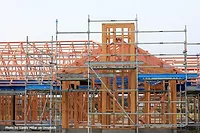Sustainable Manufacturing = Uncommon Common Sense

juststock / iStock / Getty Images Plus via Getty Images
Sustainable manufacturing practices equate to uncommon common sense. In essence, the less waste, greater efficiency, and reduced materials and energy used in the manufacturing process, the more sustainable, better for the environment, and better for the bottom line. According to the National Association of Manufacturers (NAM), sustainability is a top concern of manufacturers, and an overwhelming majority of manufacturers agree that manufacturing has a special responsibility to society to become more sustainable and accelerate the transition to a future circular industrial economy. Since manufacturers in the United States are significantly more sustainable than manufacturers in China, sustainability provides another reason for regional manufacturing and reshoring.
Sustainable Manufacturing Upgrades
Manufacturers are upgrading their equipment, processes, and programs to positively impact the triple bottom line. The most common approaches are those that are uncommon common sense. For example, a building products manufacturer focused machinery and equipment upgrades on those that would increase production efficiencies and reduce waste. It wanted to increase production with lower levels of scrap with fewer resources. Thus, the triple bottom line (profit, people, planet) came to fruition as the company reduced unnecessary costs, better engaged its team with the use of new equipment and advanced technologies, and reduced the consumption of materials.
The manufacturer also emphasized the education and training of its manufacturing workforce. It put training programs in place and added monitors on the machines that tied to a manufacturing execution system (MES) to track quality issues and highlight issues proactively. The company also brought equipment suppliers into the facility to find ways to work with the team to optimize the use of the equipment. These strategies led to reduced scrap, improved efficiencies, and better sustainability.
Energy Consumption as a Priority
Energy consumption is a hot topic in sustainability circles with lower carbon emissions as the goal. In manufacturing circles, lower energy usage is simply uncommon common sense. Lower energy usage in the plant costs less and will positively impact the environment. The source of energy will have a significant impact on carbon emissions as well. For example, coal is the dirtiest form of energy. According to Carbon Atlas, in 2020, almost 70% of China’s CO2 emissions came from coal whereas less than 20% came from coal in the United States. Worse yet, in 2022, China permitted for two coal plants per week. The bottom line is that China emits more greenhouse gases than the entire developed world combined.
Beyond being produced, product must be transported to the ports, shipped across the ocean, and transported to distribution centers and/or manufacturers in the United States before getting to the end-customer. Even with improvements across the goods movement sector, the carbon footprint adds up, and extended lead times limit flexibility to changing customer conditions and increase the total cost of the product. Adding geopolitical tensions and the increasing cost of oil and capital into the equation, manufacturers are aggressively pursuing reshoring strategies to improve service, profitability, and the planet.
In addition, manufacturers are constantly striving for ways to reduce their energy consumption to impact the triple bottom line. For example, a construction products manufacturer was consuming significant energy costs in its rubber manufacturing process. Thus, the manufacturer brought the electricity supplier into the facility to review options to minimize usage. The company was able to level load it energy usage throughout the day, thereby reducing its cost. In addition, the company partnered with a local college to find opportunities for improvement. The students and academic advisor recommended an upgrade to its ovens to minimize electricity consumption, thereby further reducing its energy consumption and costs.
Pursuing sustainability objectives is uncommon common sense for manufacturers. Anything they can do to reduce materials, energy consumption, inefficiencies, and movements will improve the carbon footprint and achieve the tripbottom line. Smart manufacturers are prioritizing process, equipment, people, and technology upgrades.
For more information, contact the author at landerson@lma-consultinggroup.com or visit www.lma-consultinggroup.com.
Looking for a reprint of this article?
From high-res PDFs to custom plaques, order your copy today!






